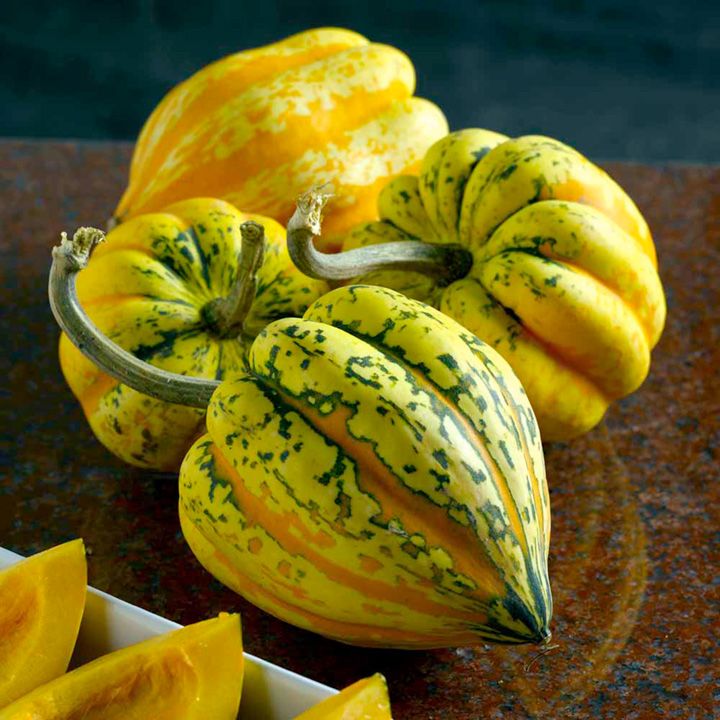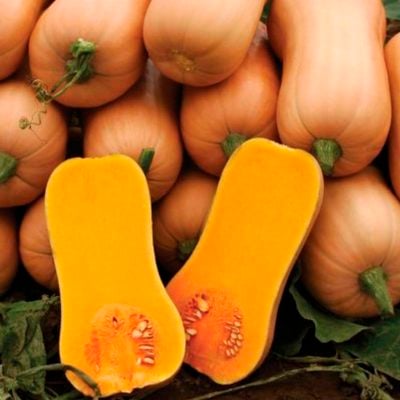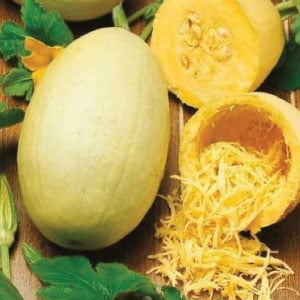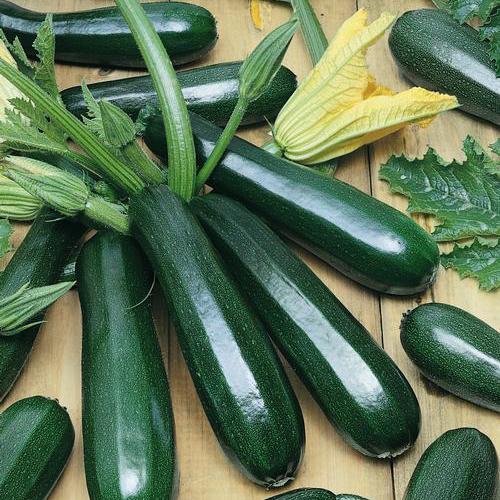
Learning Download: How to Grow Squash
From Seed to Harvest: A guide to growing squash.
Squash is a very versatile plant to grow, with many different options for the home garden. Squash is an easy plant with high yields and comes in many different varietals. Winter squashes such as acorn, delicata and butternut can be used in dishes or even for decoration as a centerpiece of a table.
To plant:
Squash grow well in mounds, so hill up some soil and plant three to five seeds per mound. plant seeds 1 inch deep in mounds set 4 feet apart after all danger of frost has passed. Squash can be started indoors three to four weeks before the last frost date. Squash also grow well in pots or buckets. A 5- or 10-gallon bucket is large enough.
To grow:
Once seedlings occur, thin to two or three per mound. Squash grow best in full sun so, if possible, plant on a south or southeast facing slope. Water at least 1 inch a week. Squash do best when in soil with a pH of 6.0 to 6.7. TO deter weeds, a light layer of mulch can be applied but squash is a sprawling plant that usually doesn’t fall victim to weeds. Mulching also can help retain moisture.
To harvest:
Summer squash varieties like zucchini and yellow squash can be harvested when they are young and tender or you can wait until they reach their full size, which is generally 6 to 8 inches long. Zucchini will have a healthy sheen to its green skin. Winter squash like acorn, delicata or butternut squashes are ready to harvest when their outer rind resists puncture by a fingernail.
To harvest, use pruning shears or scissors to snip the squash from the vine. Do not try to pull or twist the squash off the plant, as it may cause damage to the squash and the plant. Harvest frequently, as the more you harvest the more squash will grow. If a squash becomes overripe, remove it from the plant to continue encouraging more yields. Squash blossoms are also edible. Pick the first blooms that appear, as those are the males and if picked, they will not affect plant yields later in the season. Remove the interior of the blossom and add the petals to salads.
What squash craves:
Squash plants have high yields, making them a heavy feeder. To encourage squash growth, it is important to fertilize prior to planting the seeds and during its growing season as well. Prior to planting seeds, mix up to 3 inches of compost into the soil where you plan to plant the seeds. Instead of composting, you can use a 5-10-10 fertilizer and spread 1 tablespoon per mound prior to planting. Throughout the squash’s growing season, use the 5-10-10 fertilizer monthly.
Where to buy squash seeds:
You can find many varieties of squash — both winter and summer squashes such as zucchini, yellow squash, acorn, butternut, even small scallop squashes and more at Urban Farmer.
Learning Download: How to Grow Summer Squash
From Seed to Harvest: A guide to growing summer squash.
Summer squashes are a popular option for gardeners to grow due to the wonderful flavor and the ease of growing the vegetable. Summer squash includes zucchini, yellow squash, scalloped, straight neck and other varieties. Summer squashes are tender and do best when grown in warm weather.
To plant:
Begin summer squash indoors 3 to 4 weeks before your last frost date. If you are sowing the seeds directly outdoors, wait until the soil temperature has warmed to 70 degrees Fahrenheit. If the soil is still cool, you can protect the seeds or transplants by adding row covers to help warm the soil. Sow the seeds 1/2 to 1 inch deep and space them apart 12 to 18 inches, as the squash plants can become quite large. Seeds should germinate within 7 to 10 days if the weather is warm enough. If you are transplanting seedlings to the garden, wait until it has been 2 to 3 weeks after the last frost.
To grow:
Once the seedlings have sprouted, thin them to 36 inches apart in all directions. Keep the soil moist. Summer squash prefers soil with a pH of 5.5 to 6.8. The summer squash plants also prefer full sun. Some of the common pests summer squash experiences include aphids, cucumber beetles, flea beetles, slugs, snails and others, so take preventative measures against those. Be sure to not plant summer squash in an area where cucumbers or melons have recently grown. Do not opt to plant summer squash in containers, as they are likely to spread out.
To harvest:
Summer squash are best to harvest when they are still small and tender, as this is when they will taste the best. Harvest while the squash is still young. Mature squash reaches 6 to 8 inches in length. Large squash will have little taste. Be sure to cut the squash from the vine instead of pulling it so you don’t risk pulling out the whole plant. Use a sharp knife and leave about an inch of stem on the squash. Be sure to harvest all squash before the first frost.
What summer squash craves:
Some fertilizer will help your summer squash grow to its fullest extent. Prior to planting, add compost to the beds where you plan to plant the summer squash. Once the seedlings are old enough, fertilize the beds with fish emulsion or a soluble complete fertilizer at half strength.
Where to buy summer squash seeds:
Urban Farmer offers many varieties of summer squash seeds, including zucchini, scalloped squash and yellow squash. You can find summer squash seeds at Urban Farme r.
Learning Download: How to Grow Winter Squash
From Seed to Harvest: A guide to growing winter squash.
Although winter squash is grown during warm season, it’s a frost-tender vegetable. The main difference between winter and summer squash is winter squash is allowed to reach maturity on the vine in which its skin is very thick, unlike summer squash which is harvested while its skin is still soft. Popular varieties of winter squash include butternut, acorn, banana and spaghetti squash.
To plant:
Sow seeds directly into the garden no sooner than three weeks after the last frost as soil temperatures need to have warmed to at least 60 degrees Fahrenheit. Sow the seeds approximately 2 inches deep and sow them in hills, with 4 to 5 seeds per hill spaced 3 to 4 inches apart. The hills should be 6 to 12 inches tall.
To grow:
Once the squash has sprouted, thin the seedlings to the two strongest ones. Add cages or trellises around the seedlings so they have something to climb. The squash grows best in full sun and in soil with a pH of 5.5 to 6.8. Keep the soil evenly moist, because this is how squash grows best. Some of the best companion plants for winter squash includes nasturtiums, bush peas and beans. When planting, avoid planting the squash in the shade of taller plants.
To harvest:
Winter squash can take 60 to 110 days to be ready to harvest after sowing. They are ready to harvest when their rinds are full color and firm. You should not be able to dent the rind with your thumbnail when it is ready for harvest. Make sure you complete your harvest before the first hard frost. To harvest the winter squash, cut the squash from the vine, don’t pull it. When cutting it from the vine, leave two or three inches of stem on the squash because this will allow the fruit to be stored longer.
What winter squash craves:
Winter squashes can benefit from fertilizer. Prior to planting, mix an aged compost in with the soil. You should also side-dress the beds with aged compost midway through the season, In addition, you can add a side dressing of compost tea every two to three weeks throughout the squash’s growing season. If feeding with fertilizer, use a 5-10-10 blend. Avoid fertilizing the squash with a high-nitrogen fertilizer.
Where to buy winter squash seeds:
You can find a wide variety of winter squash seeds at Urban Farmer.
Learning Download: Common pests and diseases: Squash
Common pests and diseases: Squash
When growing vegetables, it is always exciting to care for the plant throughout its growing phase and then harvest it for delicious recipes later on, but one thing to watch out for is pests and diseases. Different plants are susceptible to different types of pests and diseases, and it is important to make yourself aware so you can keep a watchful eye and also take any preventative methods to keep your plants safe throughout their lifespan.
Squash can fall victim to several different pests and diseases.
Pests:
The most common pests affecting squash include aphids, armyworms and the cabbage looper, as well as others.
Aphids are soft-bodied insects that bring problems to lots of plants. They create discoloration of the leaves, necrotic spots and stunted growth. Use tolerant varieties and only apply insecticides if there’s a high infestation.
Armyworms will cause closely grouped holes in the foliage, and heavy feeding can cause leaves to become skeletonized. Squash will show shallow and dry wounds. You may see egg clusters on the leaves. To organically control armyworms, encourage natural enemies or apply Bacillus thuringiensis.
Cabbage loopers will leave large holes in the leaves and can cause lots of damage. Eggs are typically laid in singularly. To control cabbage loopers, encourage natural enemies. You can handpick them from the plants, or apply Bacillus thuringiensis to kill the larvae. Stay away from chemical sprays which might harm natural predators.
Diseases:
Some of the common diseases affecting squash include Alternaria leaf blight, Alternaria leaf spot and foot rot.
Alternaria leaf blight will cause small yellowish-brown spots with a green or yellow halo to appear on the older leaves first. Eventually, the lesions expand and the leaves will curl and die. To prevent this disease, practice crop rotation to reduce levels of inoculum, remove crop debris from the field as quickly as possible or plow it deep into the soil and be sure to apply the appropriate fungicides when applicable. Another method of prevention is to water plants at the base rather than overhead.
Alternaria leaf spot causes round or irregular lesions on older leaves. This disease prefers wet conditions, and it is a fungus. It can be controlled by practicing crop rotation, destroying all crop debris after harvest and applying the appropriate fungicides.
Foot rot causes leaves to wilt, and the wilting progresses to the entire plant, which will then die. This is also known as Fusarium crown. A distinctive, necrotic like rot will affect the upper parts of the taproot. The plant will break easily below the soil line. To prevent this disease, be sure to plant seed that has been treated by fungicides and practice good crop rotation.
Learning Download: How long to cure and store winter squash
How long to cure and store winter squash
Winter squash may grow during the warmer seasons and be harvested in the late fall, but there’s a process to be able to enjoy this squash all summer long. Winter squash can be cured and then stored, and it can be stored up to six months depending on the type of squash. Winter squash is known as a squash that is planted by seed in the spring, grown until the fall when it is harvested and then stored for its winter consumption. It differs from the summer squash, like zucchini, which cannot be stored for that long.
How to cure winter squash:
Winter squash has a long growing period, which is why it needs to be planted in the spring. It is typically ready to harvest within 80 to 110 days depending on the variety. When the squash is harvested, it needs to be cured. This means it will be prepared for long-term storage. Winter squash must be cured before it can be stored for a long time.
To cure a winter squash, let the squash sit in a warm place with good air circulation for 10-14 days. You can put the squash on an elevated rack frame, and make sure to keep the squash dry while it is curing. Certain varieties of winter squash require curing, and these are buttercup, butternut and spaghetti squash. Curing is a type of drying, which allows excess moisture to evaporate. It also slows the squash’s respiration rate, which is also required for storage. Curing also will allow natural sugars to become more concentrated, which makes the squash even sweeter. The rind will become harder, and that keeps the squash from collapsing or rotting.

Harvest the squash before the night temperatures reach the 40s. The rind should already be hard and difficult to scratch with a fingernail. The skin should be dry and dull. Make sure the stem is not broken or loose, or the squash won’t store well. Clean the squash with a dry towel and leave it to cure in 80 to 85 degrees and humidity at 80 to 85 percent.
Storing squash:
Once it has been cured, there is a correct way to store the squash. Squash should be stored in a cool, dark place between 50 to 55 degrees and relative humidity at 50 to 70 percent. Make sure you store the squash on a shelf, but not on the floor. Keep its skin dry and do not store it near ripening fruit. Check the squash weekly to make sure it isn’t rotting.
What to do with acorn squash:
Although acorn squash is a winter squash, it does not need to be cured. If you cure an acorn squash, you actually reverse the process and it won’t store as long if it has been cured.
Learning Download: Summer Squash Comparison Chart
Summer Squash Comparison Chart
| Type | Variety | Days | Length | Disease Resistance |
| Crookneck | Yellow Crookneck** | 58 | 4-6 inches | |
| Straightneck | Early Prolific Straightneck*** | 42 | 4-7 inches | |
| Scallop | Scallop Early White** | 47 | 7 inches | |
| Scallop | Yellow Bush Scallop ** | 50 | 2-3 inches | |
| Scallop | Bennings Green Tint Scallop** | 50 | 3-4 inches | |
| Tatume | Tatume | 55 | 6-8 inches | |
| Zucchini | Garden Spineless | 53 | 8 inches | PM,WMV, ZYMV |
| Zucchini | Black Beauty*** | 45 | 6-8 inches | |
| Zucchini | Spineless Beauty | 50 | 8 inches | |
| Zucchini | Dark Green | 65 | 6-8 inches | |
| Zucchini | Caserta** | 50 | 4-6 inches | |
| Zucchini | Round* | 45 | 3-4 inches | |
| Zucchini | Marrow Segev | 47 | 6-8 inches | PM |
| Zucchini | Cocozelle | 45 | 2-12 inches | |
| Zucchini | Golden | 54 | 6-8 inches |
Diseases:PM (Powdery Mildew), WMV (Watermelon Mosiac Virus), ZYMV (Zucchini Yellow Mosiac Virus)
*All American Selection Winner
**Heirloom
***AAS Winner/Heirloom
Learning Download: Winter Squash Comparison Chart
Winter Squash Comparison Chart
| Type | Variety | Days | Size | Avg. Yield Fruit/Plant |
| Acorn | Table Queen Acorn** | 80 | 1 lbs. | 4-5 |
| Acorn | Cream of the Crop*** | 100 | 2-3 lbs. | 4-5 |
| Butternut | Waltham Butternut*** | 105 | 4-5 lbs. | 4-5 |
| Butternut | Honeybaby* | 90-100 | 1-2 lbs. | 9 |
| Butternut | Early Butternut* | 82 | 2-2.5 lbs. | 4-5 |
| Butternut | Little Dipper | 100-110 | 2 lbs. | 3-4 |
| Buttercup | Buttercup Burgess** | 95 | 3-5 lbs. | 3-4 |
| Delicata/Sweet Dumpling | Delicata* | 100 | 1-3 lbs. | 5-7 |
| Delicata/Sweet Dumpling | Sweet Dumpling | 100 | 1 lbs. | 8-10 |
| Hubbard | Red Kuri | 92 | 4-7 lbs. | 2-3 |
| Hubbard | Golden Hubbard** | 105 | 8-12 lbs. | 1-2 |
| Hubbard | Blue Hubbard*** | 100 | 12-15 lbs. | 1-2 |
| Spaghetti | Vegetable Spaghetti** | 88 | 3-5 lbs. | 4-5 |
| Other Winter Squashes | Festival Winter | 95 | 1-2 lbs. | 5-7 |
| Other Winter Squashes | Kikuza** | 95 | 4-7 lbs. | 2-4 |
| Other Winter Squashes | Sweet Meat | 100 | 10-15 lbs. | 2-3 |
*All American Selection Winner
**Heirloom
***AAS Winner/Heirloom




